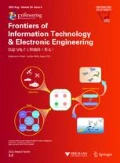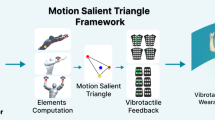Abstract
A novel 3D interactive painting method for Chinese calligraphy and painting based on force feedback technology is proposed. The relationship between the force exerted on the brush and the resulting brush deformation is analyzed and a spring-mass model is used to build a model of the 3D Chinese brush. The 2D brush footprint between the brush and the plane of the paper or object is calculated according to the deformation of the 3D brush when force is exerted on the 3D brush. Then the 3D brush footprint is obtained by projecting the 2D brush footprint onto the surface of the 3D object in real time, and a complete 3D brushstroke is obtained by superimposing 3D brush footprints along the painting direction. The proposed method has been successfully applied in a virtual 3D interactive drawing system based on force feedback technology. In this system, users can paint 3D brushstrokes in real time with a Phantom Desktop haptic device, which can effectively serve as a virtual reality interface to the simulated painting environment for users.
Similar content being viewed by others
References
Adams, B., Wicke, M., Dutré, P., et al., 2004. Interactive 3D painting on point-sampled objects. Proc. 1st Eurographics Conf. on Point-Based Graphics, p.57–66. https://doi.org/10.2312/SPBG/SPBG04/057-066
Agrawala, M., Beers, A.C., Levoy, M., 1995. 3D painting on scanned surfaces. Proc. Symp. on Interactive 3D Graphics, p.145–150. https://doi.org/10.1145/199404.199429
Baxter, W., Wendt, J., Lin, M.C., 2004. IMPaSTo: a realistic, interactive model for paint. Proc. 3rd Int. Symp. on Non-photorealistic Animation and Rendering, p.45–56, 148. https://doi.org/10.1145/987657.987665
Baxter, W.V., Lin, M.C., 2004. A versatile interactive 3D brush model. Proc. 12th Pacific Conf. on Computer Graphics and Applications, p.319–328. https://doi.org/10.1109/PCCGA.2004.1348363
Chen, Z.L., Kim, B., Ito, D., et al., 2015. Wetbrush: GPU- based 3D painting simulation at the bristle level. ACM Trans. Graph., 34(6), Article 200. https://doi.org/10.1145/2816795.2818066
Chu, N.S.H., Tai, C.L., 2002. An efficient brush model for physically-based 3D painting. Proc. 10th Pacific Conf. on Computer Graphics and Applications, p.413–421. https://doi.org/10.1109/PCCGA.2002.1167885
Chu, N.S.H., Tai, C.L., 2004. Real-time painting with an expressive virtual Chinese brush. IEEE Comput. Graph. Appl., 24(5): 76–85. https://doi.org/10.1109/MCG.2004.37
Chu, N.S.H., Tai, C.L., 2005. MoXi: real-time ink dispersion in absorbent paper. ACM Trans. Graph., 24(3): 504–511. https://doi.org/10.1145/1073204.1073221
Foskey, M., Otaduy, M.A., Lin, M.C., 2002. ArtNova: touch- enabled 3D model design. Proc. IEEE Virtual Reality, p.119–126. https://doi.org/10.1109/VR.2002.996514
Fu, C.W., Xia, J.Z., He, Y., 2010. LayerPaint: a multi-layer interactive 3D painting interface. Proc. SIGCHI Conf. on Human Factors in Computing Systems, p.811–820. https://doi.org/10.1145/1753326.1753445
Fu, Y.X., Chen, Y.H., 2008. Haptic 3D mesh painting based on dynamic subdivision. Comput. Aid. Des. Appl., 5(1–4): 131–141. https://doi.org/10.3722/cadaps.2008.131-141
Gregory, A.D., Ehmann, S.A., Lin, M.C., 2000. inTouch: interactive multiresolution modeling and 3D painting with a haptic interface. Proc. IEEE Virtual Reality, p.45–52. https://doi.org/10.1109/VR.2000.840362
Guo, C., Hou, Z.X., Yang, G.Q., et al., 2015. The simulation of the brushstroke based on force feedback technology. Math. Prob. Eng., Article 164821. https://doi.org/10.1155/2015/164821
Hanrahan, P., Haeberli, P., 1990. Direct WYSIWYG painting and texturing on 3D shapes. Proc. 17th Annual Conf. on Computer Graphics and Interactive Techniques, p.215–223. https://doi.org/10.1145/97880.97903
Hou, Z.X., Guo, C., Chen, G.Z., et al., 2015. The methods of the pigment mixing and color storage in the virtual painting. J. Inform. Comput. Sci., 12(18): 6853–6861.
Igarashi, T., Cosgrove, D., 2001. Adaptive unwrapping for interactive texture painting. Proc. Symp. on Interactive 3D Graphics, p.209–216. https://doi.org/10.1145/364338.364404
Johnson, D., Thompson, T.V., Kaplan, M., et al., 1999. Painting textures with a haptic interface. Proc. IEEE Virtual Reality, p.282–285. https://doi.org/10.1109/VR.1999.756963
Kim, L., Sukhatme, G.S., Desbrun, M., 2003. Haptic editing of decoration and material properties. Proc. 11th Symp. on Haptic Interfaces for Virtual Environment and Teleoper-ator Systems, p.213–220. https://doi.org/10.1109/HAPTIC.2003.1191280
Kim, L., Sukhatme, G.S., Desbrun, M., 2004. A haptic- rendering technique based on hybrid surface representa-tion. IEEE Comput. Graph. Appl., 24(2): 66–75. https://doi.org/10.1109/MCG.2004.1274064
Larsson, T., Källberg, L., 2013. Fast and robust approximation of smallest enclosing balls in arbitrary dimensions. Comput. Graph. Forum, 32(5): 93–101. https://doi.org/10.1111/cgf.12176
Lin, M.C., Baxter, W., Foskey, M., et al., 2002. Haptic inter-action for creative processes with simulated media. IEEE Int. Conf. on Robotics and Automation, p.598–604. https://doi.org/10.1109/ROBOT.2002.1013424
Otsuki, M., Tsukadaira, M., Kimura, A., et al., 2009. Devel-opment of brush device facilitating painting operation in 2D/3D space. Proc. ICROS-SICE Int. Joint Conf., p.4323–4326
Otsuki, M., Sugihara, K., Kimura, A., et al., 2010. MAI painting brush: an interactive device that realizes the feeling of real painting. Proc. 23rd Annual ACM Symp. on User Interface Software and Technology, p.97–100. https://doi.org/10.1145/1866029.1866045
Author information
Authors and Affiliations
Corresponding author
Additional information
Project supported by the National Natural Science Foundation of China (No. 51175058)
Rights and permissions
About this article
Cite this article
Guo, C., Hou, Zx., Shi, Yz. et al. A virtual 3D interactive painting method for Chinese calligraphy and painting based on real-time force feedback technology. Frontiers Inf Technol Electronic Eng 18, 1843–1853 (2017). https://doi.org/10.1631/FITEE.1601283
Received:
Accepted:
Published:
Issue Date:
DOI: https://doi.org/10.1631/FITEE.1601283




